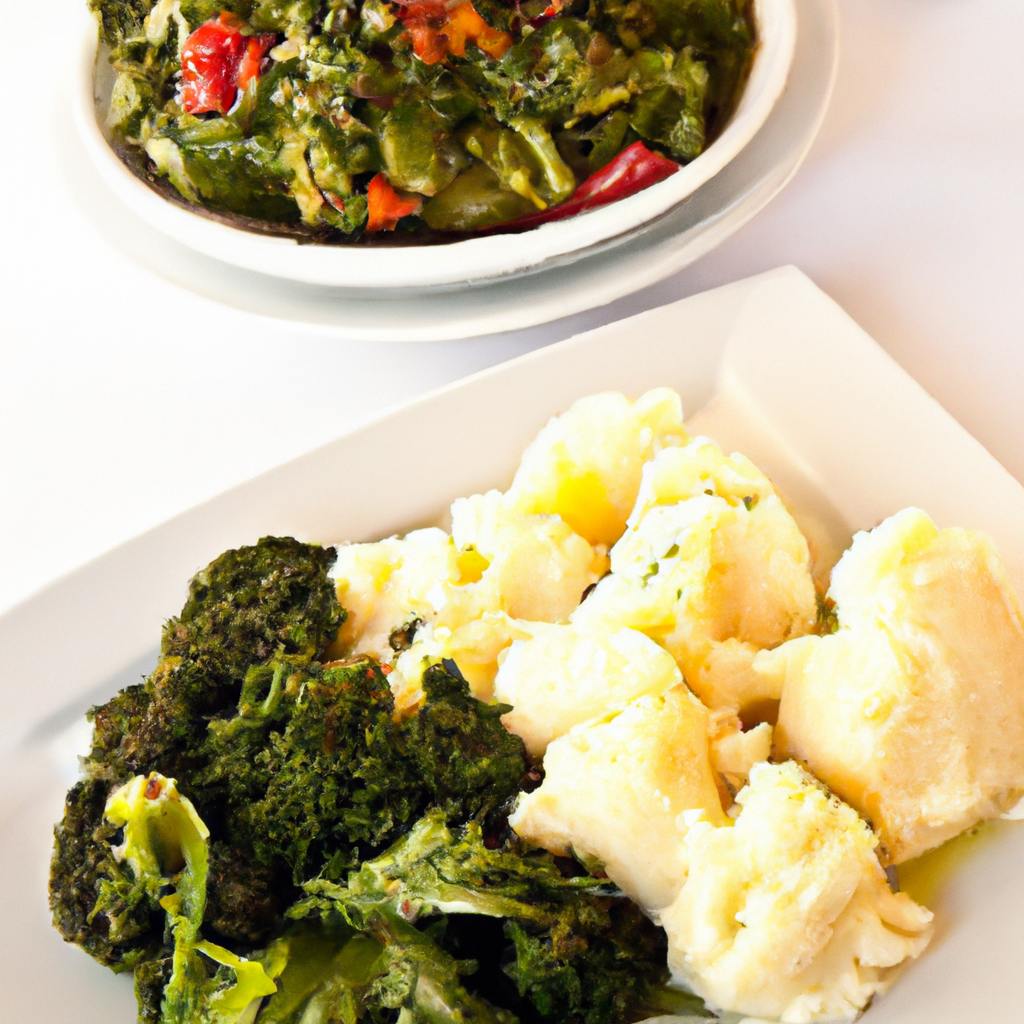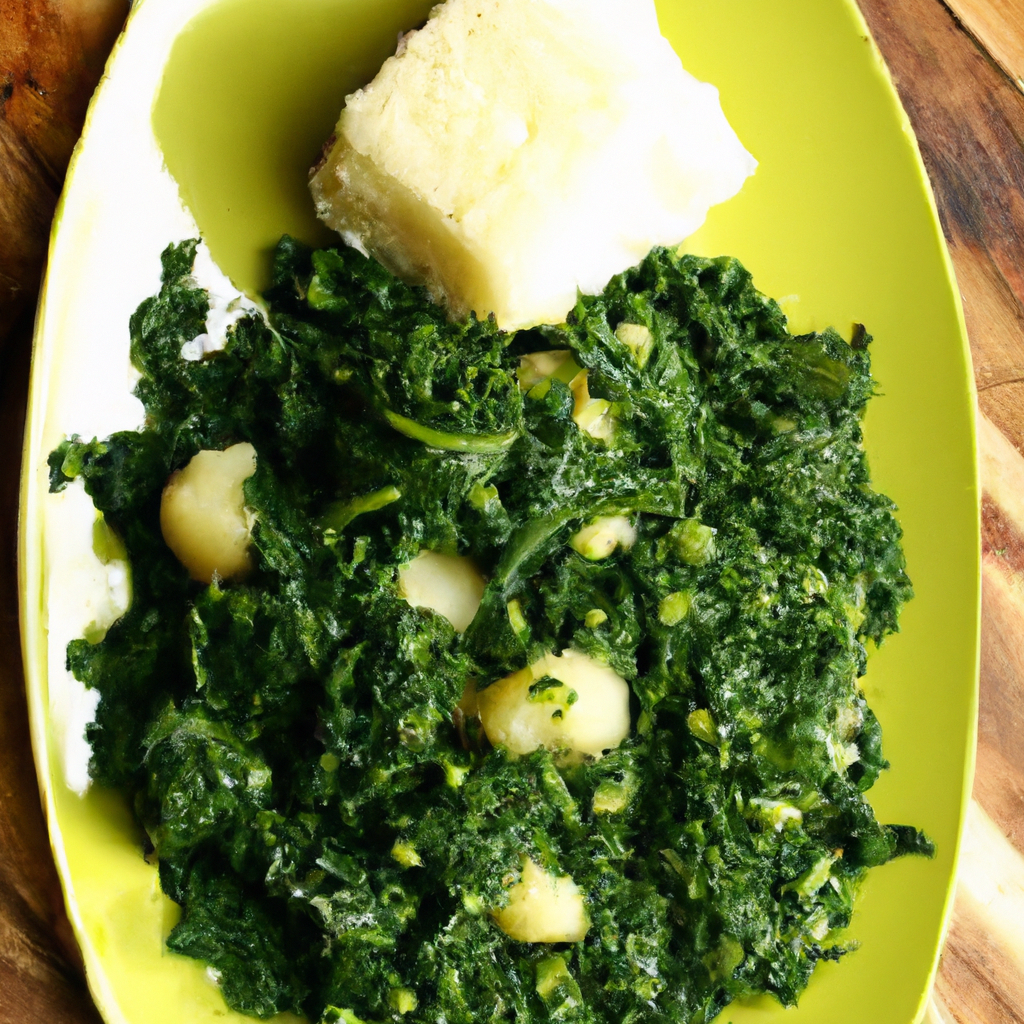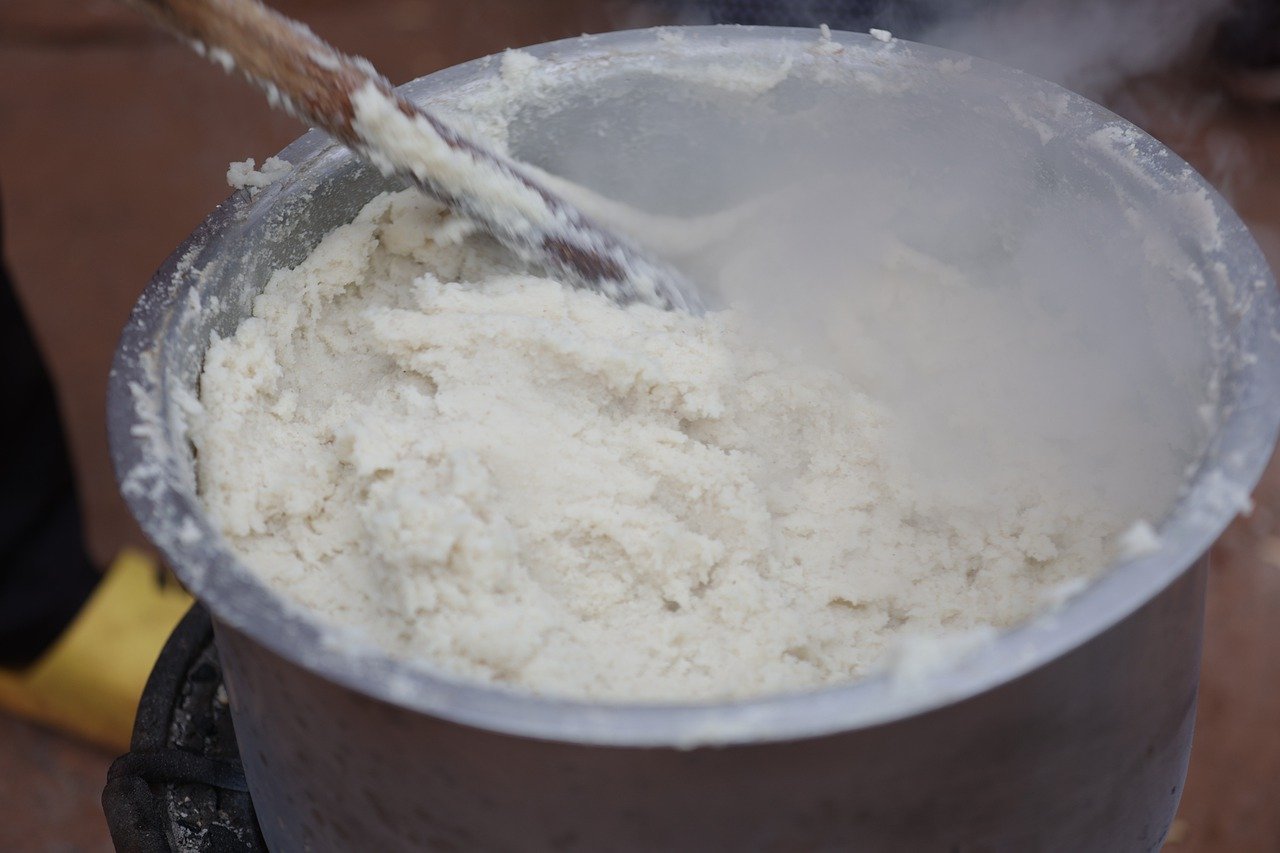Ugali (Corn Meal) With Sukuma Wiki (Collard Greens)
Imagine yourself walking through the vibrant streets of Nairobi, enveloped in the tantalizing aromas of Kenyan cuisine. As you delve into the rich and diverse culinary culture of this East African nation, one dish in particular captivates your senses: Ugali with Sukuma Wiki. This iconic combination of cornmeal and collard greens showcases the heart and soul of Kenyan cooking, where simplicity meets incredible flavor. From the first bite, you’ll be transported to the bustling local markets and bustling eateries, savoring every mouthful of this delightful meal.
What is Ugali?
Introduction to Ugali
Ugali is a staple food in many African countries, particularly in Kenya, Tanzania, and Uganda. It is a simple, yet satisfying dish made from cornmeal or maize flour. Ugali has a thick and doughy consistency, similar to polenta or porridge. This versatile dish has been a part of African cuisine for centuries and is commonly enjoyed with a variety of stews, vegetables, or sauces.
Ingredients of Ugali
To make Ugali, you only need two main ingredients: maize flour and water. Maize flour, which is made from finely ground corn, gives Ugali its distinct texture and flavor. Water is used to create a thick paste by gradually adding it to the flour. However, some variations of Ugali may include adding a pinch of salt or oil to enhance the taste.
Cooking process of Ugali
The cooking process of Ugali is quite simple. Start by bringing water to a boil in a saucepan. Gradually add maize flour to the boiling water, stirring continuously to avoid any lumps. As the mixture thickens, lower the heat and continue stirring until the Ugali reaches a smooth, thick consistency. It is essential to keep stirring to prevent the mixture from sticking to the bottom of the saucepan. Once cooked, remove from heat and let it cool for a few minutes before serving.
What is Sukuma Wiki?
Introduction to Sukuma Wiki
Sukuma Wiki, which translates to “stretch the week” in Swahili, is a popular East African dish made from collard greens or kale. It is named as such because it was historically considered a way to stretch meals or make them last longer. Traditionally, Sukuma Wiki is a simple and affordable vegetable dish that has become a favorite among many households in the region.
Ingredients of Sukuma Wiki
The key ingredient in Sukuma Wiki is collard greens or kale. These leafy greens are rich in nutrients and provide a hearty dose of vitamins and minerals. Other common ingredients include onions, tomatoes, garlic, and various spices such as cumin, paprika, or chili flakes. Optionally, you can also add meat or beans for added protein and flavor.
Cooking process of Sukuma Wiki
To prepare Sukuma Wiki, start by washing and chopping the collard greens or kale into bite-sized pieces. Heat oil in a large pan or pot and sauté the onions and garlic until they become fragrant and translucent. Add the tomatoes and spices, allowing them to cook for a few minutes before adding the collard greens or kale. Stir and cook until the greens are wilted but still vibrant green. Add salt to taste and simmer for a few minutes until the flavors meld together. Serve hot with Ugali for a delicious combination.

The Perfect Pair: Ugali and Sukuma Wiki
Why Ugali and Sukuma Wiki are a popular pair
Ugali and Sukuma Wiki complement each other perfectly, creating a meal that is both delicious and fulfilling. The soft, neutral taste of Ugali balances well with the flavorful and slightly bitter greens of Sukuma Wiki. Together, they create a harmony of textures and flavors that is loved by many.
Nutritional benefits of combining Ugali and Sukuma Wiki
Combining Ugali and Sukuma Wiki also offers numerous health benefits. Ugali provides a good source of carbohydrates, which are essential for energy. Sukuma Wiki, on the other hand, is rich in vitamins, minerals, and fiber. The combination of the two creates a balanced meal that nourishes the body and provides a wide range of nutrients.
Cultural significance of Ugali and Sukuma Wiki
Ugali and Sukuma Wiki hold immense cultural significance in East Africa, particularly in Kenya. These dishes are deeply rooted in the culinary heritage and are often associated with family meals, social gatherings, and celebrations. They represent a sense of community and togetherness, bringing people together to share a meal and bond over the love for their culture.
Ugali Recipe
Ingredients needed
- 2 cups of maize flour
- 4 cups of water
- Pinch of salt (optional)
- 1 tablespoon of oil (optional)
Step-by-step cooking process
- In a saucepan, bring the water to a boil.
- Gradually add the maize flour to the boiling water, stirring continuously to avoid lumps.
- Lower the heat and continue stirring until the mixture thickens to a smooth, thick consistency.
- Optional: Add a pinch of salt and a tablespoon of oil for enhanced flavor.
- Remove from heat and let it cool for a few minutes before serving.
Tips for making the perfect Ugali
- While stirring, use a wooden spoon or whisk to ensure a smooth consistency.
- Gradually add the maize flour to the water to prevent lumps from forming.
- Adjust the amount of water or maize flour based on the desired consistency of Ugali.
- Let the Ugali rest for a few minutes before serving to allow it to set.

Sukuma Wiki Recipe
Ingredients needed
- 1 bunch of collard greens or kale
- 1 onion, chopped
- 2 tomatoes, chopped
- 2 cloves of garlic, minced
- 1 tablespoon of oil
- Spices (cumin, paprika, chili flakes) to taste
- Salt to taste
Step-by-step cooking process
- Wash the collard greens or kale thoroughly and chop them into bite-sized pieces.
- Heat oil in a large pan or pot over medium heat.
- Sauté the chopped onions and minced garlic until fragrant and translucent.
- Add the chopped tomatoes and spices, stirring well.
- Add the chopped collard greens or kale to the pan and cook until wilted but still vibrant green.
- Season with salt to taste and simmer for a few minutes to allow the flavors to meld together.
- Serve hot with Ugali for a wholesome meal.
Variations and additions to Sukuma Wiki
- For added protein, you can include cooked beans or diced meat such as beef, chicken, or fish.
- Sprinkle some lemon juice or vinegar over Sukuma Wiki for a tangy twist.
- Add diced bell peppers or carrots for added color and texture.
Health Benefits of Ugali
Rich source of energy
Ugali is a rich source of energy due to its high carbohydrate content. Carbohydrates provide the body with fuel and are essential for physical activities and daily functions.
Good source of carbohydrates
As a staple food made primarily from maize flour, Ugali is an excellent source of carbohydrates. Carbohydrates are vital for the body as they provide energy and play a crucial role in brain function.
Contains essential minerals
Maize flour, the main ingredient in Ugali, contains essential minerals such as iron and zinc. Iron helps in the formation of red blood cells, while zinc supports the immune system and aids in various bodily functions.
Health Benefits of Sukuma Wiki
High in vitamins and minerals
Sukuma Wiki, being a leafy green vegetable, is packed with vitamins and minerals. It is a great source of vitamins A, C, and K, along with minerals like calcium, potassium, and iron. These nutrients are essential for maintaining good overall health and supporting various bodily functions.
Aids in digestion
The high fiber content in Sukuma Wiki promotes healthy digestion and prevents constipation. It adds bulk to the diet and supports the proper functioning of the gastrointestinal system.
Boosts immune system
The combination of vitamins, minerals, and antioxidants found in Sukuma Wiki helps boost the immune system. A strong immune system is crucial for fighting off infections and diseases.
Ugali and Sukuma Wiki in Kenyan Cuisine
Traditional Kenyan staple food
Ugali and Sukuma Wiki are considered traditional staple foods in Kenya. They are deeply ingrained in Kenyan cuisine and are enjoyed by people from all walks of life, whether in households or restaurants.
Popular in households and restaurants
Ugali and Sukuma Wiki are not only popular at home but also widely served in Kenyan restaurants. They are often found on menus as a complete meal or as a side dish to accompany meat or other vegetable dishes.
Celebratory and festive occasions
Ugali and Sukuma Wiki often make appearances during celebratory and festive occasions in Kenya. They are commonly served during gatherings, weddings, or religious festivals, signifying unity and abundance.
Different Variations of Ugali
Adding maize flour to water
The traditional method of making Ugali involves gradually adding maize flour to boiling water. This creates a thick, doughy consistency. However, the amount of maize flour can be adjusted based on personal preference, with some people preferring a softer or firmer Ugali.
Adding other flours for variation
While maize flour is the most common choice for making Ugali, other flours can be added to create variations in taste and texture. Some popular additions include millet flour, sorghum flour, or cassava flour. These variations can add a slightly different flavor profile to the dish.
Using different cooking techniques
Ugali can be cooked using various techniques, such as steaming or baking. Steamed Ugali results in a softer texture, while baked Ugali has a slightly crusty exterior. These alternative cooking methods offer different experiences and can be explored for a change in taste and texture.
Conclusion
Ugali and Sukuma Wiki: A delicious and nutritious combination
Ugali and Sukuma Wiki form a perfect pairing that is loved for its simplicity, nutritional benefits, and cultural significance. The soft and comforting Ugali, when paired with the nourishing and flavorful Sukuma Wiki, creates a meal that is both satisfying and healthy.
Recipes to try at home
Give Ugali and Sukuma Wiki a try at home with the provided recipes. Share the experience with your loved ones and explore the joys of East African cuisine.
Embracing the cultural significance of Ugali and Sukuma Wiki
Beyond the food itself, Ugali and Sukuma Wiki represent the warmth of African culture and the power of community. Embrace the cultural significance of these dishes by sharing them with others and appreciating the traditions they hold.
So, next time you want to indulge in a meal that is both delicious and nutritious, remember to pair Ugali with Sukuma Wiki for a taste of East Africa’s culinary delights.


